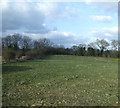
Mooring here is ok (a perfectly adequate mooring), mooring pins are needed.
There is a bridge here which takes a track over the canal.
| Site of John's Wharf | 1 mile, 1 furlong | |
| Hatton Winding Hole | 7 furlongs | |
| Hatton Station Bridge No 56 | 3½ furlongs | |
| Mid-Warwickshire Yacht Club | 3 furlongs | |
| Gallows Bridge No 57 | 1¾ furlongs | |
| Ball's Bridge No 58 | ||
| Shrewley Tunnel (southeastern entrance) | 1¾ furlongs | |
| Shrewley Tunnel (northwestern entrance) | 3¾ furlongs | |
| Shrewley Tythe Barn Bridge No 59 | 4¾ furlongs | |
| Castle Meadow Bridge No 60 | 6½ furlongs | |
| White Bridge No 61 | 1 mile, 2¼ furlongs | |
- Grand Union Canal Walk — associated with Grand Union Canal
- An illustrated walk along the Grand Union Canal from London to Birmingham
Mouseover for more information or show routes to facility
Nearest water point
In the direction of Budbrooke Junction
In the direction of Camp Hill Top Lock Winding Hole
Nearest rubbish disposal
In the direction of Budbrooke Junction
In the direction of Camp Hill Top Lock Winding Hole
Nearest chemical toilet disposal
In the direction of Budbrooke Junction
In the direction of Camp Hill Top Lock Winding Hole
Nearest place to turn
In the direction of Budbrooke Junction
In the direction of Camp Hill Top Lock Winding Hole
Nearest self-operated pump-out
In the direction of Camp Hill Top Lock Winding Hole
Nearest boatyard pump-out
In the direction of Budbrooke Junction
In the direction of Camp Hill Top Lock Winding Hole
Wikipedia has a page about Ball's Bridge
A ball is a round object (usually spherical, but can sometimes be ovoid) with various uses. It is used in ball games, where the play of the game follows the state of the ball as it is hit, kicked or thrown by players. Balls can also be used for simpler activities, such as catch or juggling. Balls made from hard-wearing materials are used in engineering applications to provide very low friction bearings, known as ball bearings. Black-powder weapons use stone and metal balls as projectiles.
Although many types of balls are today made from rubber, this form was unknown outside the Americas until after the voyages of Columbus. The Spanish were the first Europeans to see the bouncing rubber balls (although solid and not inflated) which were employed most notably in the Mesoamerican ballgame. Balls used in various sports in other parts of the world prior to Columbus were made from other materials such as animal bladders or skins, stuffed with various materials.
As balls are one of the most familiar spherical objects to humans, the word "ball" may refer to or describe spherical or near-spherical objects.
"Ball" is used metaphorically sometimes to denote something spherical or spheroid, e.g., armadillos and human beings curl up into a ball, we make a ball with our fist.







![Grand Union Canal: Bridge Number 58: Ball's Bridge. Ball's Bridge is a farmers' bridge. It is nameless on the 1905 Edition of the large scale Ordnance Survey map, but credited on the 1925 Edition.Totally coincidentally Roger's [[1709858]] was taken 4 years previously to the day. Evidently the old sign on the parapet has since dropped off.From this position one can see right through Shrewley Tunnel to the next bridge beyond. by Nigel Cox – 06 September 2012](https://s3.geograph.org.uk/geophotos/03/18/86/3188647_fab48350_120x120.jpg)









![Trees along a stream, Shrewley. Between the railway and the Grand Union Canal, south of Ball's bridge [no. 58]. by Christine Johnstone – 10 June 2025](https://s0.geograph.org.uk/geophotos/08/19/01/8190188_8bdbd612_120x120.jpg)
![Footbridge over the railway northwest of Hatton station. It carries a footpath between Little Shrewley and Great Pinley. It's little used: the approach on each side is obstructed by a stile, brambles, nettles and buddleia. [[1923141]] is a view back from the bridge. by Robin Stott – 04 August 2018](https://s0.geograph.org.uk/geophotos/06/16/84/6168452_eb2a4726_120x120.jpg)
![Footpath by a railway embankment nearing a footbridge. Steps left of centre take the path up to trackbed level. [[1923141]] is a view back from the footbridge. by Robin Stott – 04 August 2018](https://s2.geograph.org.uk/geophotos/06/16/84/6168434_884e4a1f_120x120.jpg)











![Footpath by a railway embankment northwest of Hatton station. Here a small metal footbridge takes it across a brook that is then culverted under the railway. The path leads to a big metal footbridge: [[1923141]] is a view back from it. by Robin Stott – 04 August 2018](https://s2.geograph.org.uk/geophotos/06/16/83/6168398_68fa11c9_120x120.jpg)


